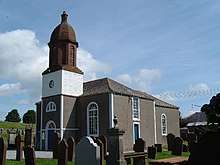Kirkbean
Kirkbean is a small Scottish village and civil parish on the Solway Firth, in the historical county of Kirkcudbrightshire and now in Dumfries and Galloway. In the 2001 census, the four small villages making up the parish of Kirkbean had a total population of 643. The parish also includes the hamlet of Loaningfoot.
| Kirkbean | |
|---|---|
 Kirkbean Location within Dumfries and Galloway | |
| Population | 643 (2001 Census)[1] |
| OS grid reference | NX978592 |
| Council area | |
| Lieutenancy area | |
| Country | Scotland |
| Sovereign state | United Kingdom |
| Police | Scotland |
| Fire | Scottish |
| Ambulance | Scottish |

History
The parish was the departure point for thousands of Scots seeking a better life in the American and Australian colonies during the late 18th and early 19th centuries. Convicts were also transported to Australia from here, making the parish a rich source of genealogical history.
Prominent residents
In birth order:
- John Campbell, a notable seafarer, was born in the village in 1720. He went on to become a British naval officer, a navigation expert, and colonial governor of Newfoundland, now a province of Canada.
- James Craik (/kreɪk/; c. 1727—1814) was Physician General (precursor of the Surgeon General) of the United States Army, as well as being George Washington's personal physician and close friend.
- John Paul Jones, founder of the United States Navy and a rear admiral in the Imperial Russian Navy, was born on the Arbigland estate on 6 July 1747. There is a memorial font to him in the church, by sculptor George Henry Paulin, which depicts USS Bonhomme Richard.
- Helen Craik, a poet and novelist, was born at Arbigland in 1751.
- William Stewart Ross (1844–1906), the Scottish writer and publisher, was also born in Kirkbean. He was a noted secularist thinker who used the pseydonym "Saladin".
- Jean Thurot (1755–1833), son of François Thurot, a French naval commodore and privateer, was buried in Kirkbean cemetery.
- Sir James Gunn (1893–1964), artist, lived with his family in Carsethorn during World War II.[2]
Natural heritage
The local beaches and the bird-rich merse (salt marsh), where large numbers of seabirds live or over-winter, are part of the natural heritage of the parish. Visitors to the National Nature Reserve on the far side of the River Nith come to watch birds on the Carsethorn foreshore, before continuing to the nature reserves at Southwick and Mersehead.
The village has an official community website.[3]
References
- KS01 Usual resident population, Kirkbean, scrol.gov.uk, 21 April 2001, archived from the original on 19 May 2011, retrieved 25 September 2008
- Retrieved 28 September 2016.